#rediscovery
Text
Here’s some positivity for systems who have recently rediscovered their plurality!
For many systems, their process of plural discovery can be messy, complicated, or difficult to understand. Some systems may have members who completely forget about their multiplicity, only to rediscover it later on. There is nothing wrong with forgetting, rediscovering, or struggling to come to terms with or remember your systemhood! This post is for all those who are rediscovering or re-questioning their plurality!
🌸 Shoutout to those who rediscovered their plurality after being made to forget for their own safety!
🕊 Shoutout to those who aren’t sure whether or not they are plural despite having identified as such in the past!
💕 Shoutout to empty systems who have recently realized that they are in fact empty systems rather than singlets!
🦢 Shoutout to dualconscious systems who forget about their plurality from time to time!
🌸 Shoutout to systems who feel like they’re in a constant state of discovery or rediscovery!
🕊 Shoutout to those who rediscovered their system after forgetting due to being fakeclaimed, hurt, or traumatized in some way!
💕 Shoutout to those with complex dissociative disorders whose dissociative barriers makes it difficult for them to maintain awareness of their system!
🦢 Shoutout to those who rediscovered their system after forgetting due to having memory issues of any kind!
🌸 Shoutout to individual headmates who have recently realized or remembered that they’re not alone in their own minds!
🕊 Shoutout to systems whose process of rediscovery has been challenging, upsetting, or painful!
💕 Shoutout to systems who have easily embraced their plurality after their rediscovery!
Having multiple instances of system discovery is actually a normal and common aspect of the questioning process for many systems. If you have recently rediscovered your plurality after forgetting about it, hiding it, or brushing it aside for any reason, we want to let you know that we see you, we believe you, and your rediscovery does not invalidate your plurality in any way, shape, or form! Know that you belong in the plural community, and we are so very happy to have you here!
If you’ve rediscovered your plurality recently, please don’t go hard on yourself for forgetting or refusing to acknowledge your system. What matters most is that you have made progress on your journey of self-discovery! Even if you forget again in the future, that doesn’t negate your progress whatsoever. Please remember to take it easy and have some patience and compassion for yourself and your system! Thank you so much for reading, and take care!

#multiplicity#plurality#pluralgang#actuallyplural#system positivity#plural positivity#plural pride#system pride#rediscovery#syscovery#trauma mention#fakeclaiming mention
78 notes
·
View notes
Text
In the words of Kafka, the sentiment that anything we hold dear is prone to slipping from our grasp resonates deeply. The truth of his observation is undeniable: the things we cherish most are often ephemeral, destined to fade away. Yet, within this paradox lies a glimmer of hope. Love, a force that defies reason and transcends boundaries, possesses an innate resilience. It may elude us in its familiar form, slipping through our fingers like grains of sand. But as time unfolds its intricate tapestry, love has a way of reemerging, transformed and reimagined. It manifests anew, a testament to its enduring nature. Kafka's insight serves as a poignant reminder that the cycle of loss and rediscovery is an intrinsic facet of the human experience, an enigmatic dance between vulnerability and resurgence.
.
#love#loss#resilience#transformation#human experience#kafka#rediscovery#vulnerability#emotions#philosophy#reflection#relationships#life's paradoxes#enduring bonds
47 notes
·
View notes
Text





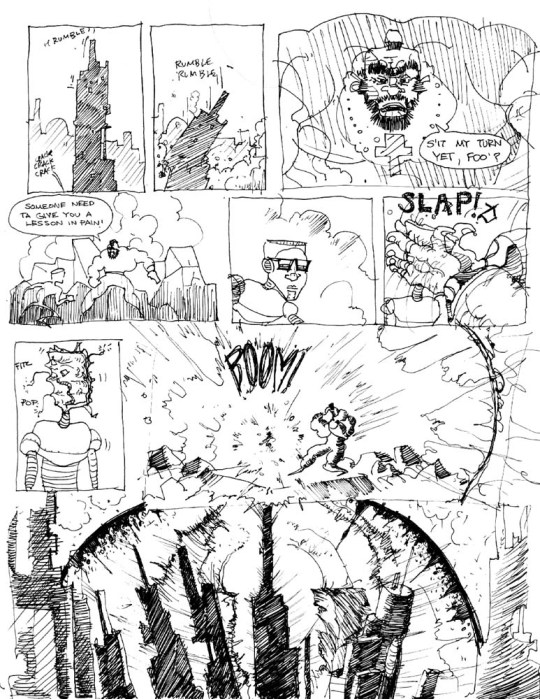

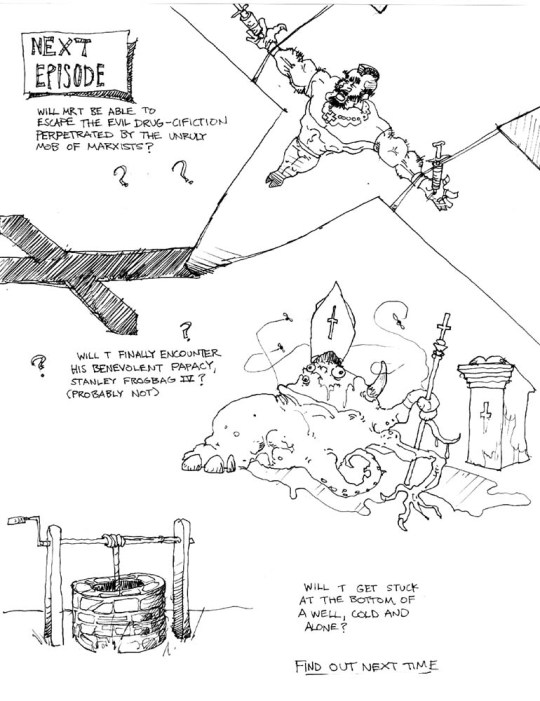
This is Totally T. Andrew Hussie made this comic as early as 1997, back when he was 17-18 years old.
I first got note of this back when he made this Discord post about his days going to Kinko's and making zines with his family:
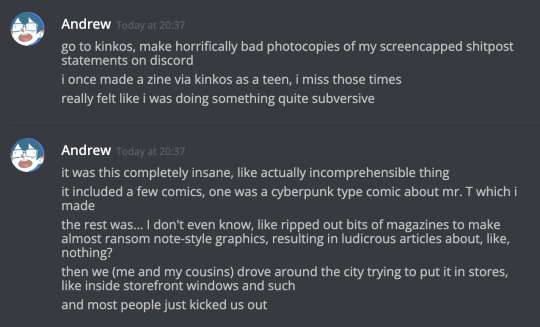
Absolutely interesting, don't you think? To see one of Hussie's earliest works as a teen?
12 notes
·
View notes
Text
Sipping a cup of coffee this morning in a restaurant, I had noticed something which was very interesting. It was a rush hour but in spite of that people while passing by this restaurant paused their glance for a little while. So what's so special that's holding their attention, even if it be for a brief moment? Well, this outlet had a large tinted glass, so the ones inside can watch outside but those outside will only find their own clear reflection. So basically the human psychology is very simple. What we humans are seeking is nothing more than one's own reflection. Our pursuit is more centred towards knowing ourselves, getting acquainted with oneself. Now this also leads to another natural conclusion that my existence in itself is irrelevant unless someone could find their reflection in me, unless they find my existence at a spot that deeply resonates with them, my purpose is bogus if I'm self-inviting but it becomes divine when i proclaim:
"Lean in a little and peep here inside me, only to find and discover yourself..."
Random Xpressions
14 notes
·
View notes
Text
The "fairy lantern" is an otherworldly species of bioluminescent plant that doesn’t need the Sun to make energy. Instead, it parasites other underground organisms.
6 notes
·
View notes
Text

The western red cicada, Okanagana arctostaphylae, was thought to be extinct for 100 years until a picture of the rare bug was snapped by a citizen scientist. Photograph By Anton Sorokin
How An ‘Extinct’ Cicada Was Rediscovered 100 Years Later
Billions of Cicadas will Soon Flood the Eastern U.S. But their Western Counterparts are Relatively Lesser Known—with One Species Described as "The Holy Grail of Western Cicada Rediscoveries."
— By Anton Sorokin | March 04, 2024
When the striking crimson red cicada known scientifically as Okanagana arctostaphylae was last seen in 1915, World War One was entering its second year, and the House of Representatives just declined a proposal allowing women to vote.
It would be over a century later in 2020 when Lucinda Collings Parker happened across one in her garden in California’s Sierra Nevada foothills. Spotting a bug she didn’t recognize, she took a picture and uploaded it to the online citizen science forum iNaturalist.
In less time than it takes to cook and eat dinner, her observation had already been seen by Will Chatfield-Taylor, an entomologist who studied at the University of Kansas, who forwarded it to a cadre of cicada experts. Jeff Cole, research associate at the Natural History Museum of Los Angeles County, and Elliott Smeds, research associate at the California Academy of Sciences, all three agreed—Parker’s cicada was O. arctostaphylae, the holy grail of western cicada rediscoveries.
This spring, from Oklahoma to Virginia, billions of cicadas will disrupt baseball games and weddings, creating an incredible sight and overwhelming chorus. But for entomological mystery, some researchers turn their eyes to the West.
There are far more species of cicada west of the Rockies than east, and these western species are comparatively poorly known. Some species are being recorded for the first time in generations. The poster-bug of these rediscoveries is Okanagana arctostaphylae.
Searching For A Lost Species
In the days after Parker’s observation, Smeds drove for hours across the western slopes of California’s Sierra Nevada mountains with his windows rolled down, listening for the cicadas' call. He had an idea of what they might sound like based on related species.
The strategy paid off, but the first time Smeds tracked them, he could only listen to the ‘zzzzzzzzZZZZzzzztttt’ of their song emanating from an inaccessible cliffside 20 feet overhead. The next day, he found them calling behind a locked gate. He was lucky and met the landowner, who, albeit slightly bemused, allowed Smeds to chase cicadas on his property.
It wasn’t long until Smeds saw them: 1.5-inch-long red insects, dramatic in coloration and appearance. They would stand out if they didn’t perch on the equally red stems of their host plants, Manzanita shrubs. Several weeks after their reappearance, the cicadas vanished again. But now scientists knew where and when to look; they were found again in 2023.
Diligent searching and several more lucky iNaturalist observations revealed the cicadas were found across a wider swathe of California's Western Sierra Foothills than expected. Now the expanse between the northernmost and southernmost observations spanned 130 miles, a distance surpassing the length of Delaware. They were able to evade detection for a century because they spend years underground. When adults emerge, it is in stifling heat and amid dense vegetation.
“Cicadas are basically overgrown aphids,” laughs Cole.
Like aphids and other ‘true bugs’ the cicadas have a ‘straw’ that they stab into plants to suck a liquid diet of sap. This has been a successful strategy for them; over 3000 cicada species are found worldwide.
They’re also characterized by a two-part life cycle. Cicadas spend the longest portion of their lives underground as nymphs, sucking juices from roots. After one to 17 years, depending on the species, they burst from the ground and molt, transforming from a brown bean-shaped subterranean creature to a winged adult—the world’s noisiest insects.
Unlike their eastern counterparts, whose emergence can be predicted decades in advance, the life cycles of western cicadas remain comparatively mysterious. What is their range? When will they emerge, and for how long? Many species have “protoperiodical” life cycles, which means that a few emerge every year, but there are much larger emergences some years, although smaller in contrast to the periodical cicadas of the east.
Figuring out exactly what triggers the emergence of protoperiodical cicadas in the West is still an unanswered question, but rain is a key part of the puzzle. Of studied species, large emergences of protoperiodical cicadas occurred only after a certain threshold of rain fell over several years.

Science Done By The Citizens
Just in California, there are about 80 recognized cicada species, and yet there are just a handful of entomologists focusing on western cicadas. Cicadas have remained relatively poorly studied because their long lifecycles and sporadic emergences are difficult for academics to study. Rarely can scientists wait years for study subjects to pop up above ground, and they can’t be everywhere at once.
Community scientists on iNaturalist have emerged as a critical tool. iNaturalist users snap a photo of a plant or animal, and the photo is immediately visible to a community of naturalists and experts who can confirm or correct an identification.
“I’m guessing a similar situation has happened hundreds of times over the last century, that someone has found this cool red bug when they’re out there in the foothills, and thanks to iNaturalist, this is just the first time that anyone else has been able to hear about it,” suggests Smeds.
iNaturalist users generate tens of thousands of observations daily. Never before have researchers of rare creatures had so many eyes peeled—peering into crevices, scanning thickets, and uploading their finds in real-time. When it comes to cicadas, over 8,500 users made nearly 17,000 records in the western U.S. as of February 2024. Suddenly, the handful of cicada scientists have eyes everywhere.
This is a game changer for cicada research. “Before iNaturalist, there was no way to know where and when they’re coming out. You needed to have a big tank of gas and some luck” recalls Cole.
Chatfield-Taylor sometimes messages users who have logged rare cicadas, asking them to collect and send him a specimen, which allows him to analyze how closely they’re related to other, nearby species and just how many might live out West.
Despite all the new records, some species continue to evade detection.
Chatfield-Taylor wistfully talks of a cicada from Yakima Valley in Washington that hasn’t been seen since its description in the 1930s.
“Maybe it's extinct” he says, or maybe it will turn up on iNaturalist this year.
Already, crowdsourcing information and specimens from iNaturalist, the cicada researchers have gotten their hands on more species faster than they would have believed possible.
These records aren’t only good for species rediscoveries. As a result of iNaturalist and specimens that they were able to obtain, Cole, Chatfield-Taylor, and Smeds determined that several species of western cicada weren’t species at all; they were geographic variants of other more widespread species.
Chatfield-Taylor wants to remind community scientists, “When it comes to western cicadas keep your eyes peeled; you might find something that surprises you.” And for that matter, your find might surprise the entomologists too.
#Cicadas#Extinct Species#Citizen Science#Rediscovery#Anton Sorokin#Lost Species#California's Western Sierra Foothills
4 notes
·
View notes
Text
Very happy that the article also mentioned the locals that helped the research team explore the forest (albeit super briefly)
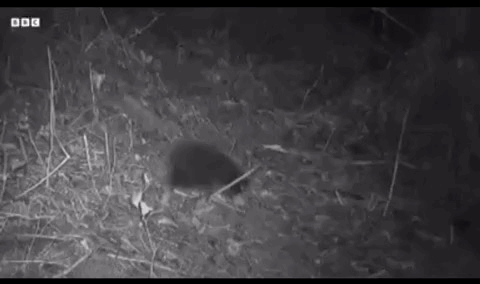
#aslzoology#asl zoology#zoology articles#studyblr#echidna#rediscovery#animals#cute animals#naturecore#environment
7 notes
·
View notes
Text
Rediscovering the missing part of yourself CAN be amazing
Good morning my beautiful and lovely amazing rockstar friends,I hope that you have a Fantastic Friday.Here's today's inspiring video: https://youtube.com/shorts/y9pkjD8YQbs?si=MevaHKUCi9tGBHYyI also posted two new quizzes for those who are interested.With love, your friend Mariah
2 notes
·
View notes
Text
Reason to Live #7734
To continue experiencing things I enjoy that I temporarily forgot about. – Guest Submission
(Please don't add negative comments to these posts.)
#sad#help#hope#reason to live#depressed#depression#empty#alone#mental illness#anxiety#trauma#guest submission#mental health#experiences#experiencing#enjoy#enjoyment#rediscovery#interests
55 notes
·
View notes
Text

This album had me last year going wild and I just rediscovered it today
#Spotify#always forever#static#albums#musicindustry#indie music#rediscovery#hell is a teenage girl#manic pixie dream girl#girl blogging#girl interrupted syndrome#random posts
4 notes
·
View notes
Text
Spotted-tailed Quoll Rediscovered
A Beachport farmer first spotted the nationally endangered animal this week, after attacks on his chickens.
National Parks and Wildlife Service rangers visited the property and trapped the animal overnight on Wednesday.
The species, which is considered extinct in South Australia, was last officially recorded in the Mount Burr Forest and near Robe in the 1880s.
2 notes
·
View notes
Text
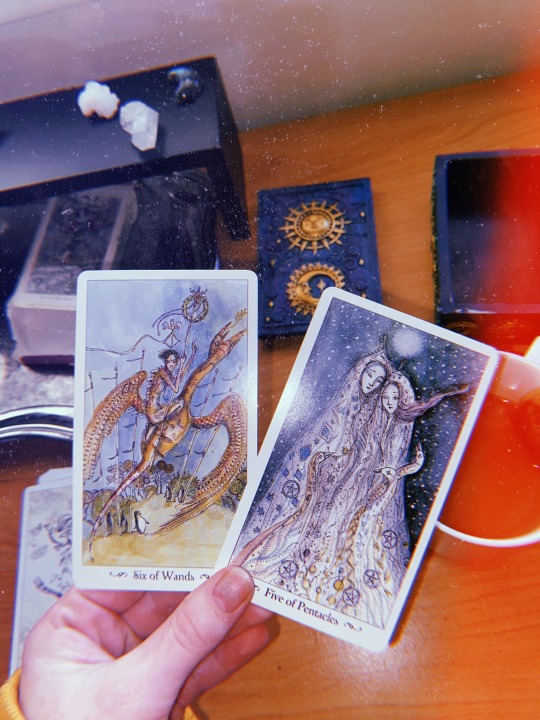
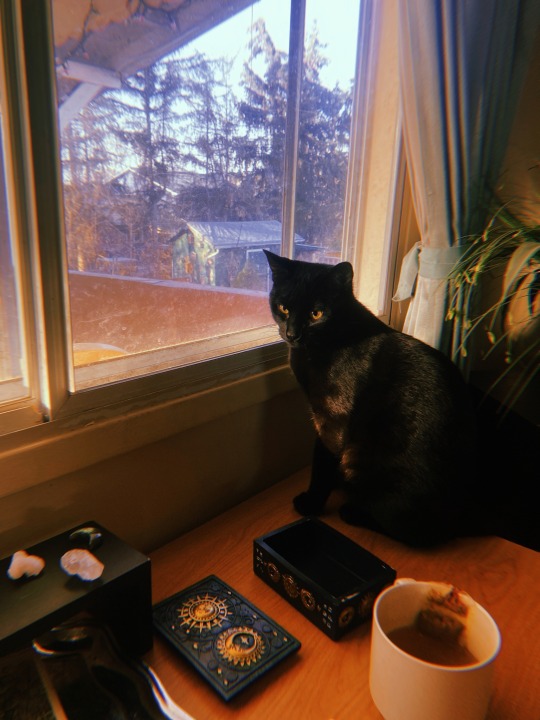
Morning pull✨
Today I am rediscovering hope
#tarotoftheday#tarot#black cat#morning#crystals#spiritualhealing#spiritual healing#spiritual growth#divine feminine#divine timing#rediscovery#hope#seek the light in every situation
10 notes
·
View notes
Text
Film & Night
It's intriguing how life makes us revisit lessons we thought we had learnt. My recent plunge back into film photography and my newfound appreciation for the Nikon F5's robustness was marred only by its weight. This beautiful but bulky beast tipped the scales at a back-breaking 2kg with my heaviest lens, often making me leave it behind in favor of my DSLR. That's when the FM2N entered my life.

This nimble camera, weighing a featherlight 300g, was an absolute joy to work with. It may have been restricted to a 50mm 1.4 lens, but the lightness of the setup filled me with a renewed sense of vigor. However, there was a downside: with a fixed film ISO, I was confined to daytime photography or risked grainy, unusable photos. Considering my work schedule is skewed to the night, I found myself leaning back on my trusty DSLR again. But life had a surprise up its sleeve.

Last evening, while rummaging through my luggage, I discovered a pair of forgotten companions - two flashes! My first instinct was to pair the compact SB400 with the FM2N, but alas, their electronic incompatibility was a setback. The alternative was the hulking SB600. A check with some online forums confirmed it could work with the FM2N. With a shrug and a spark of adventurous spirit, I decided to give it a shot.

Suddenly, I was thrust back into the world of manually setting up a flash. This was a task I had long abandoned in favor of built-in flash and auto modes on my digital gear. With my FM2N mounted with the SB600, I was suddenly the center of attention, drawing curious gazes from people around me. It felt just like the early days with the Zenith TTL and its quirky Soviet flash.
It was back to the basics for me, reading the scene, adjusting the settings, and dealing with the flash's imposing presence. Each captured moment was a balance between the right exposure, perfect timing, and managing not to startle anyone in my vicinity. This was not what I had signed up for, but here I was, trying to master the flash all over again, this time with an old film camera and a more seasoned perspective.



Night photography with film isn't as simple as cranking up the ISO on a DSLR, but this rediscovered tool promised a new horizon of possibilities. My journey with film, flashes, and learning to shoot in the dark is far from over, but with each click and flash, I can see myself getting closer to perfecting the art. From the silent streets of Bali to the vibrant scenes of everyday life, my FM2N, armed with the SB600 flash, is ready to capture it all in its grainy glory.




Stay tuned for the results of this enlightening adventure. Let's hope the images speak louder than the flash itself!
2 notes
·
View notes
Text
That moment, that special second in time, when you rediscover your love of an actor - fucking magical.
15 notes
·
View notes
Text
Find A Song
about rediscovering something lost, even if it looks very different than before
Thomas LaVine - Idle Daylight
LaVine explains that "Idle Daylight" is a song that resulted from him exploring what his lost faith and spirituality mean to him: "In simple terms, the song is almost a rediscovery of something lost, even if it looks very different than before", as Thomas said.
(source)
Added to FAS Spotify playlist indie folk/country/americana.
#music#music blog#indie music#alternative music#indie folk#Thomas LaVine#Idle Daylight#rediscovery#indie#alternative#find a song
2 notes
·
View notes
Text

If you don’t know where you are from, you don’t know where you are.
#bhudda#black tumblr#paradisaicalhoney#blackskin#red#skin#brownskin#mama#black bhudda#dravidians#spill some tea#spill the truth#truth#Indians#indigineous people#sun#selfie#in other news#rediscovery#google it#answers#womban#stretched ears#ancient history#antiquity#ifGod#if you know you know#if you don’t know now you know. if god color doesn’t matter#why is he never represented as black#the uncanny truth teller
12 notes
·
View notes